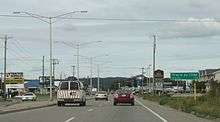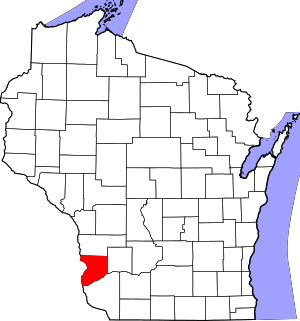Prairie du Chien, Wisconsin
Prairie du Chien (/ˌprɛri du ˈʃiːn/) is a city in and the county seat of Crawford County, Wisconsin, United States. The population was 5,911 at the 2010 census. Its ZIP Code is 53821.[4]
City of Prairie du Chien | |
|---|---|
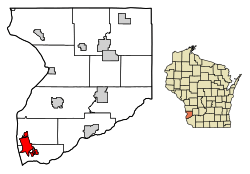 Location of Prairie du Chien in Crawford County, Wisconsin. | |
| Coordinates: 43°03′06″N 91°08′29″W | |
| Municipality | City |
| Area | |
| • Total | 6.47 sq mi (16.76 km2) |
| • Land | 5.84 sq mi (15.13 km2) |
| • Water | 0.63 sq mi (1.63 km2) |
| Population | |
| • Total | 5,911 |
| • Estimate (2019)[3] | 5,572 |
| • Density | 953.62/sq mi (368.18/km2) |
| Time zone | UTC−6 (Central) |
| • Summer (DST) | UTC−5 (CDT) |
| ZIP Code | 53821 |
| Area code(s) | 608 |
| FIPS code | 55-65050 |
| Website | www.prairieduchien.info |
Often referred to as Wisconsin's second oldest city,[5] Prairie du Chien was established as a European settlement by French voyageurs in the late seventeenth century. The city is located near the confluence of the Wisconsin and Mississippi rivers, a strategic point along the Fox-Wisconsin Waterway that connects the Great Lakes with the Mississippi.
Early French visitors to the site found it occupied by a group of Fox Indians led by a chief whose name Alim meant chien in French (dog in English).[6][7] The French explorers named the location Prairie du Chien, French for "Dog's Prairie". Originally this name applied only to the plain upon which the settlement is located, but it was later applied to the city as well. The city of Prairie du Chien is located between the Town of Prairie du Chien and the Town of Bridgeport.
History
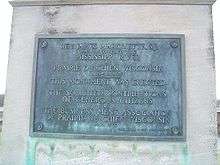
The first known Europeans to reach Prairie du Chien were French explorers Jacques Marquette and Louis Joliet, who arrived by canoe on June 17, 1673, discovering a route to the Mississippi River. Later travel between Canada and the Mississippi River continued to pass through Prairie du Chien, although routes via the Illinois River were also used. In 1685, the French explorer Nicolas Perrot established a trading post in the area as part of the large and lucrative French fur trade industry. After Americans entered the trade in the nineteenth century, John Jacob Astor built the Astor Fur Warehouse, an important building in the regional fur trade, which was centered in Prairie du Chien. The significance of Prairie du Chien as a center of the fur trade did not diminish until the mid-nineteenth century, when European demand declined, as did game stock.
In 1763, after Great Britain defeated France in the French and Indian War (part of the Seven Years' War), it took possession of the French territory in North America east of the Mississippi River, including Prairie du Chien. During the American Revolutionary War, the city was used as a meeting point for British troops and their Native American allies. After the American victory, the Treaty of Paris (1783) granted the area to the new United States of America, but the British and their Loyalists were slow to withdraw. Only after the War of 1812 did the city become fully American.
The US was slow to present any authority over Prairie du Chien, but late in the War of 1812 when the government realized the importance of holding the site to prevent British attacks from Canada, it began construction of Fort Shelby in 1814. In July, British soldiers captured the fort during the Siege of Prairie du Chien. The British maintained control over the city until the war's end in 1815. Not wanting another invasion through Prairie du Chien, the Americans constructed Fort Crawford in 1816.
The fort was the site of the negotiations and signing of the Treaties of Prairie du Chien (1825 and 1830), by which the Fox and Sauk ceded much of their land to the US. Representing them and the United Nations of the Chippewa, Ottawa and Pottawatomie in the 1829 negotiations was Billy Caldwell, of Scots-Irish and Mohawk descent. He became involved with the Pottawatomie after moving to the US as a young man from Canada.
In 1829, the army doctor William Beaumont carried out many of his famous experiments on digestion in the hospital of Fort Crawford. Beaumont's discoveries are still the basis of current knowledge on the human digestive process.
Col. Zachary Taylor, who later became the 12th U.S. President, was the commanding officer at Fort Crawford during the Black Hawk War of 1832. Taylor oversaw the surrender of Black Hawk in Prairie du Chien. Lt. Jefferson Davis, who later became president of the Confederate States of America, was stationed at Fort Crawford at the same time. Here Jefferson Davis met Zachary Taylor's daughter, Sarah "Knoxie" Taylor, whom he married in 1835.[9]
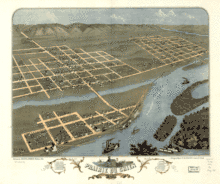
Outside the walls of the fort, early nineteenth century life in Prairie du Chien was still dominated by the fur trade. Prairie du Chien's most well-known traders during this time were Michel Brisbois, Joseph Rolette, Nathan Myrick, and Hercules L. Dousman. Dousman built a fortune in the fur trade, which, combined with income from investments in land, steamboats, and railroads, propelled him to become the first millionaire in Wisconsin. Dousman died in 1868, and his son, H. Louis Dousman, inherited much of his fortune. In 1870 Louis Dousman used his inheritance to construct a luxurious Victorian mansion over the site of the former Fort Shelby. When Louis died unexpectedly in 1886, his family renamed the home "Villa Louis" in his memory. The Dousman family continued to occupy the home until 1913. Nearly 40 years later, in 1952, the mansion became Wisconsin's first state-operated historic site.
After the fur trade declined in the mid-nineteenth century, Prairie du Chien's attention shifted to agriculture and the railroad. Although the city was first connected to the Milwaukee & Mississippi Railroad in 1857, the width of the Mississippi River posed a challenge for further expansion of the railroad into Iowa. This problem was temporarily solved by disassembling the trains at Prairie du Chien and ferrying them across the river to be put back on the tracks on the other side. A better solution was found by Michael Spettel and John Lawler, who designed the permanent Pile-Pontoon Railroad Bridge to span the river in 1874. Lawler took most of the credit for this invention, and made a small fortune through its operation. The bridge remained in use until its removal in 1961.
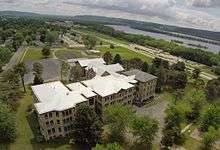
Lawler later donated property to establish two Catholic boarding schools in Prairie du Chien, St. Mary's Institute (now Mount Mary College of Milwaukee), and Campion High School in the later part of the century. St. Mary's College remained in Prairie du Chien until 1928.[10] Campion High School produced several notable alumni, including Vicente Fox, Congressman Leo Ryan, Governor Patrick Lucey, actors David Doyle, George Wendt, and Kevin McCarthy, and writer Garry Wills. Campion was closed in 1975.
History of municipal government
Prairie du Chien was incorporated as the Borough of Prairie des Chiens on September 17, 1821 by the secretary of the Michigan Territory.[11] It is the only municipality in Wisconsin other than Green Bay to have been known as a borough, rather than a city, town, or village.[12] The borough existed for a few years before the government stopped operating in 1825[13]
In 1828, the Prairie du Chien area became a part of the Town of St. Anthony, a town which included all of immense Crawford County. (Crawford County itself included all of the western part of Michigan Territory.) In 1849, the Town of Prairie du Chien was created, consisting of most of present-day Crawford County. The city of Prairie du Chien was then incorporated in 1872.[14]
Geography
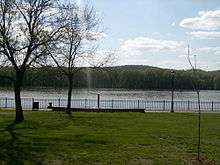
Prairie du Chien is located within the Mississippi River Valley, upon a long triangular plain that is bounded on the west by the Mississippi River, on the south by the Wisconsin River, and on the east-northeast by a series of tall bluffs. According to the United States Census Bureau, the city has a total area of 6.36 square miles (16.47 km2), of which, 5.63 square miles (14.58 km2) of it is land and 0.73 square miles (1.89 km2) is water.[15] While the city's area encompasses most of the plain upon which it sits, portions of the plain extend outside city limits. Just north of the city limits, where the plain forms part of the Town of Prairie du Chien, there is a small unincorporated settlement known locally as "Frenchtown". The plain also extends outside the city southward into the Town of Bridgeport. Here the plain ends, becoming the wetlands of the Wisconsin River Delta.
Both inside and outside the city limits, backwaters of the Mississippi River occasionally break across the far west side of the plain to form small islands. While most of these islands are too small and flood prone to have ever been inhabited, one larger island just west of downtown Prairie du Chien formed the city's fourth ward until a 1965 flood prompted a mandatory relocation of the island's residents to higher ground. During the relocation project, most buildings with no special historical significance were removed. Now called "St. Feriole Island", the island serves as a 240-acre (1.0 km2) city park.[16]
Climate
The data below were accessed via the WRCC and were recorded from 1893 through the date this chart was made (January 2020).[17]
Prairie du Chien has recorded the highest temperatures in Wisconsin for the months of January, March, May, September, and November.[18]
| Climate data for Prairie du Chien, Wisconsin | |||||||||||||
|---|---|---|---|---|---|---|---|---|---|---|---|---|---|
| Month | Jan | Feb | Mar | Apr | May | Jun | Jul | Aug | Sep | Oct | Nov | Dec | Year |
| Record high °F (°C) | 66 (19) |
70 (21) |
89 (32) |
96 (36) |
109 (43) |
105 (41) |
110 (43) |
106 (41) |
104 (40) |
93 (34) |
85 (29) |
67 (19) |
110 (43) |
| Mean maximum °F (°C) | 46.2 (7.9) |
50.9 (10.5) |
67.5 (19.7) |
80.6 (27.0) |
87.9 (31.1) |
93.3 (34.1) |
96.4 (35.8) |
94.7 (34.8) |
90.7 (32.6) |
81.7 (27.6) |
66.7 (19.3) |
50.9 (10.5) |
97.6 (36.4) |
| Average high °F (°C) | 28.5 (−1.9) |
32.8 (0.4) |
45.3 (7.4) |
60.7 (15.9) |
72.5 (22.5) |
81.3 (27.4) |
86.2 (30.1) |
84.0 (28.9) |
75.8 (24.3) |
64.0 (17.8) |
46.9 (8.3) |
32.5 (0.3) |
59.2 (15.1) |
| Average low °F (°C) | 8.9 (−12.8) |
12.5 (−10.8) |
24.3 (−4.3) |
36.9 (2.7) |
48.1 (8.9) |
57.7 (14.3) |
61.9 (16.6) |
59.8 (15.4) |
51.6 (10.9) |
40.6 (4.8) |
27.9 (−2.3) |
15.3 (−9.3) |
37.1 (2.8) |
| Mean minimum °F (°C) | −16.6 (−27.0) |
−11.7 (−24.3) |
2.6 (−16.3) |
21.4 (−5.9) |
32.9 (0.5) |
43.8 (6.6) |
50.0 (10.0) |
47.5 (8.6) |
35.1 (1.7) |
23.9 (−4.5) |
9.0 (−12.8) |
−8.5 (−22.5) |
−20.4 (−29.1) |
| Record low °F (°C) | −37 (−38) |
−36 (−38) |
−33 (−36) |
0 (−18) |
21 (−6) |
34 (1) |
38 (3) |
35 (2) |
20 (−7) |
4 (−16) |
−17 (−27) |
−26 (−32) |
−37 (−38) |
| Average precipitation inches (mm) | 1.02 (26) |
1.10 (28) |
1.93 (49) |
3.01 (76) |
3.92 (100) |
4.29 (109) |
3.62 (92) |
3.96 (101) |
3.52 (89) |
2.27 (58) |
1.93 (49) |
1.30 (33) |
31.87 (810) |
| Average snowfall inches (cm) | 9.3 (24) |
7.0 (18) |
6.3 (16) |
1.3 (3.3) |
0.6 (1.5) |
0 (0) |
0 (0) |
0 (0) |
0 (0) |
0.1 (0.25) |
2.4 (6.1) |
8.2 (21) |
35.2 (90.15) |
| Source: https://wrcc.dri.edu/cgi-bin/cliMAIN.pl?wi6827 | |||||||||||||
Geology
The city gives its name to the Prairie du Chien Dolomite, a layer of dolomite widely found in western Wisconsin.
Demographics
| Historical population | |||
|---|---|---|---|
| Census | Pop. | %± | |
| 1860 | 2,398 | — | |
| 1870 | 2,700 | 12.6% | |
| 1880 | 2,777 | 2.9% | |
| 1890 | 3,131 | 12.7% | |
| 1900 | 3,232 | 3.2% | |
| 1910 | 3,149 | −2.6% | |
| 1920 | 3,537 | 12.3% | |
| 1930 | 3,943 | 11.5% | |
| 1940 | 4,622 | 17.2% | |
| 1950 | 5,392 | 16.7% | |
| 1960 | 5,649 | 4.8% | |
| 1970 | 5,540 | −1.9% | |
| 1980 | 5,859 | 5.8% | |
| 1990 | 5,659 | −3.4% | |
| 2000 | 6,018 | 6.3% | |
| 2010 | 5,911 | −1.8% | |
| Est. 2019 | 5,572 | [3] | −5.7% |
| U.S. Decennial Census[19] | |||
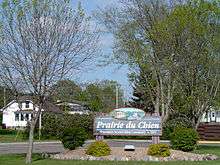
2010 census
As of the census[2] of 2010, there were 5,911 people, 2,386 households, and 1,367 families residing in the city. The population density was 1,049.9 inhabitants per square mile (405.4/km2). There were 2,594 housing units at an average density of 460.7 per square mile (177.9/km2). The racial makeup of the city was 93.6% White, 4.5% African American, 0.4% Native American, 0.3% Asian, 0.3% from other races, and 0.9% from two or more races. Hispanic or Latino of any race were 1.2% of the population.
There were 2,386 households, of which 26.6% had children under the age of 18 living with them, 41.9% were married couples living together, 10.9% had a female householder with no husband present, 4.4% had a male householder with no wife present, and 42.7% were non-families. 37.6% of all households were made up of individuals, and 17.8% had someone living alone who was 65 years of age or older. The average household size was 2.18 and the average family size was 2.86.
The median age in the city was 41.4 years. 21.6% of residents were under the age of 18; 8% were between the ages of 18 and 24; 24.9% were from 25 to 44; 27.3% were from 45 to 64; and 18.3% were 65 years of age or older. The gender makeup of the city was 52.4% male and 47.6% female.
2000 census
As of the census[20] of 2000, there were 6,018 people, 2,376 households, and 1,473 families residing in the city. The population density was 1,075.9 people per square mile (415.7/km2). There were 2,564 housing units at an average density of 458.4 per square mile (177.1/km2). The racial makeup of the city was 95.06% White, 3.61% Black or African American, 0.28% Native American, 0.17% Asian, 0.02% Pacific Islander, 0.08% from other races, and 0.78% from two or more races. 0.88% of the population were Hispanic or Latino of any race.
There were 2,376 households, out of which 29.3% had children under the age of 18 living with them, 48.7% were married couples living together, 10.2% had a female householder with no husband present, and 38.0% were non-families. 33.0% of all households were made up of individuals, and 17.1% had someone living alone who was 65 years of age or older. The average household size was 2.28 and the average family size was 2.92.
In the city, the population was spread out, with 24.2% under the age of 18, 11.4% from 18 to 24, 24.3% from 25 to 44, 21.8% from 45 to 64, and 18.3% who were 65 years of age or older. The median age was 38 years. For every 100 females, there were 100.5 males. For every 100 females age 18 and over, there were 97.3 males.
The median income for a household in the city was $34,038, and the median income for a family was $43,444. Males had a median income of $29,595 versus $20,183 for females. The per capita income for the city was $17,680. About 6.4% of families and 8.1% of the population were below the poverty line, including 11.7% of those under age 18 and 4.8% of those age 65 or over.
Culture
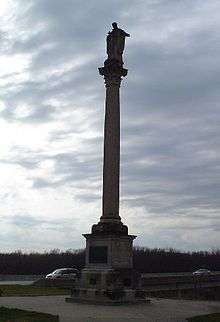
Prairie du Chien has five National Historic Landmarks and nine sites on the National Register of Historic Places representing its significant history. The five Landmarks were the first designated in the state.
It is close to Wyalusing State Park in Wisconsin, and Effigy Mounds National Monument and Pikes Peak State Park in Iowa, sites of natural and manmade wonders. Its rich history and location by the Mississippi River, make the city a popular destination for tourists. The Prairie Villa Rendezvous, a gathering to recreate the atmosphere of a 19th-century fur trading camp, has been held annually in the city every Father's Day weekend since 1975, it attracts tens of thousands of visitors.
In 2001, Prairie du Chien gained brief national attention for its first annual New Year's Eve celebration, during which a carp from the Mississippi River was dropped from a crane over BlackHawk Avenue at midnight. The "Droppin' of the Carp" celebration has been held every New Year's Eve since.
Hunting and fishing have long been popular in the area. The opening of Cabela's fourth outlet store in the city in 1998 firmly established the city as a destination for sportsmen.
Transportation
Prairie du Chien is served by the Prairie du Chien Municipal Airport (KPDC).
Media
Prairie du Chien's twice weekly newspaper is the Courier Press, which also publishes a weekly shopping supplement distributed to area households and businesses. Other print media in the area includes the Wisconsin-Iowa Shopping News, which is distributed to 19,297 homes and businesses weekly.[21]
Crawford County is in the La Crosse/Eau Claire broadcast media market as monitored by ACNielsen. The local cable system also carries some channels from the Madison market and some residents are also able to receive over the air broadcasts from stations in the Cedar Rapids/Waterloo/Dubuque market.
Prairie du Chien is home to WQPC, a 36,000-watt radio station broadcasting at 94.3FM. The station is located near the banks of the Mississippi River on St. Feriole Island. It has a sister station, WPRE 980 AM. Other stations with strong reception in Prairie du Chien include WHHI 91.3FM, WGLR 97.7FM and KCTN 100.1FM.
Economy
Aside from its somewhat larger than average tourist trade, Prairie du Chien's economy is similar to most other Midwestern cities of its size. Retail, service, and manufacturing jobs employ most of the city's residents. Major employers include 3M and Cabela's. State and local government are also major employers, as the city is the site of the Crawford County courthouse and offices, as well as a state penitentiary. Prairie du Chien has one of Wisconsin's busiest ports on the Mississippi River. Two railroads and a small two-runway municipal airport make the city a transport and shipping hub for the area.
Education
The Prairie du Chien School District is a public school district headquartered in Prairie du Chien, in Crawford County, Wisconsin, United States. It serves the city of Prairie du Chien, the nearby town of Bridgeport, and the village of Eastman. The district comprises three schools, all located in Prairie du Chien:
- B. A. Kennedy Elementary School (early childhood education - grade 1).
- Bluff View Intermediate School (grades 2-8)
- Prairie du Chien High School (grades 9-12)
The administrative offices for the district are located at B. A. Kennedy Elementary School.
Prairie Catholic School, a private K-8 school associated with St. Gabriel's and St. John's Catholic Churches, and Prairie Christian Academy, a private K-12 school associated with Bible Baptist Church, are also located in Prairie du Chien.
Recreation
The annual 7-day, 500-mile supported bike tour of Wisconsin known as GRABAAWR begins in Eagle River and ends in Prairie du Chien.
St. Feriole Island has a long riverfront with a park, connected to a bike path that goes around the island. Shelters can be used for large events. Across from the Villa Louis is a large open field that was once used as a horse racing track. On the far end of the field are two large soccer fields. Pets are allowed to run in the large fields as well.
Notable people
- Matthew Antoine (b. 1985), bronze medalist in men's skeleton at the 2014 Winter Olympics in Sochi, Russia
- William Beaumont, Army doctor in 1820s, carried out experiments on human digestion system at Fort Crawford hospital
- Barbara Bedford (1908–1981), silent film and Western actress
- Nicholas Boilvin (1761–1827), 19th Century frontiersman
- Pat Bowlen (1944–2019), owner of the Denver Broncos
- Michel Brisbois (1759–1837), voyageur
- Benjamin Bull, lawyer and Wisconsin State Senator
- Walter Bradford Cannon (1871–1945), physiologist who first developed concepts of fight or flight and homeostasis
- William D. Carroll, Wisconsin State Senator
- Jefferson Davis, President of Confederate States of America, was stationed at Fort Crawford in the 1830s
- Hercules Louis Dousman (1800–1868), real estate speculator and Wisconsin's first millionaire
- Alexander Faribault, trading post operator and Minnesota territorial legislator
- Buel Hutchinson, lawyer and politician
- Daniel Harris Johnson, state Representative
- Edward I. Kidd, Wisconsin state legislator and businessman
- Wiram Knowlton (1816–1863), Wisconsin Supreme Court
- Daniel W. Lawler, mayor of Saint Paul, Minnesota
- Henry Leavenworth (1783–1834), U.S. army officer in War of 1812 and against Plains Indians
- James Henry Lockwood (1793-1857), lawyer, merchant, fur trapper
- Patrick Joseph Lucey (1918-2014), U.S. diplomat; 38th Governor of Wisconsin (1971–1977)
- Frederic O. MacCartney (1864-1903), Unitarian minister and Massachusetts socialist state legislator
- Thomas Mower McDougall (1845–1909), U.S. Army officer
- John Muir (1838–1914), conservationist and founder of Sierra Club, employed at boarding house in Prairie du Chien before attending University of Wisconsin–Madison[22]
- Maurice Oehler (Chemist), founder of the National Mole Day Foundation
- John Powers, NFL player
- Leo Ryan (1925–1978), U.S. Representative from California
- Rodney J. Satter, state Representative
- Paul Scherrman, Iowa state legislature
- Daniel Bartlett Stevens, state Representative
- Joseph M. Street (1782–1840), U.S. Army officer and U.S. Indian agent to the Winnebago, Sauk, and Fox tribes after the Black Hawk War
- Jeremiah Burnham Tainter (1836–1920), engineer who invented Tainter gate
- Ormsby B. Thomas, U.S. Representative
- William Miller Wallace (1844–1924), U.S. Army general
- Wapello (1787–1842), Native American chief of Fox tribe
- George Wendt (b. 1948), actor who portrayed Norm Peterson in television series Cheers, attended Campion High School in Prairie du Chien[23]
- Brad Williams, memory specialist
References
- "2019 U.S. Gazetteer Files". United States Census Bureau. Retrieved August 7, 2020.
- "U.S. Census website". United States Census Bureau. Retrieved 2012-11-18.
- "Population and Housing Unit Estimates". United States Census Bureau. May 24, 2020. Retrieved May 27, 2020.
- "Free ZIP Code Lookup with area code, county, geocode, MSA/PMSA, population". www.zipinfo.com.
- William J. Anderson and William A. Anderson (ed.). The Wisconsin Blue Book 1929. Madison: Democrat Printing Company, 1929, p. 629.
- Trewartha, Glenn T. (June 1932), "The Prairie du Chien Terrace: Geography of a Confluence Site", Annals of the Association of American Geographers, 22 (2): 119–158, doi:10.1080/00045603209357104, JSTOR 2560587
- "Wisconsin Historical Markers: Marker 116: Prairie du Chien".
- "Vertefeuille, Francois, House". Wisconsin Historical Society. Retrieved 2012-02-03.
- "Davis, Jefferson (in Wisconsin): Confederacy President's Experience in Wisconsin". Wisconsin Historical Society. 2012-08-03.
- "Mount Mary's History". Mount Mary University.
- "An Act to incorporate the Borough of Prairie des Chiens", Sept. 17, 1821, in Laws of the Territory of Michigan vol. 1. p. 236.
- David E. Spencer. "Local Government in Wisconsin", in Collections of the State Historical Society of Wisconsin, vol. XI. Madison, Wisconsin: Democrat Printing Co., 1888. p. 505.
- Daniel S. Durrie. "Annals of Prairie du Chien". 1872.
- History of Crawford and Richland Counties, Wisconsin. Springfield, Ill.: Union Publishing Co., 1884, p.644.
- "US Gazetteer files 2010". United States Census Bureau. Archived from the original on 2012-01-25. Retrieved 2012-11-18.
- "Prairie du Chien's St. Feriole Island, an abundance of history". Wisconsin Central. Archived from the original on August 8, 2008.
- "PRAIRIE DU CHIEN, WISCONSIN - Climate Summary". wrcc.dri.edu. Retrieved 2020-01-15.
- "CLIMATOLOGICAL EXTREMES FOR WISCONSIN". www.aos.wisc.edu. Retrieved 2020-01-15.
- "Census of Population and Housing". Census.gov. Retrieved June 4, 2015.
- "U.S. Census website". United States Census Bureau. Retrieved 2008-01-31.
- "Wisconsin-Iowa Shopping News: Frequent Questions". Archived from the original on July 16, 2011. Retrieved May 19, 2009.
- "Recollections of John Muir in Prairie du Chien, 1860-61". Wisconsin Historical Society.
- "Archived copy". Archived from the original on 2014-05-18. Retrieved 2014-05-17.CS1 maint: archived copy as title (link)
Further reading
- Lucy Eldersveld Murphy, Great Lakes Creoles: A French-Indian Community on the Northern Borderlands, Prairie du Chien, 1750-1860. New York: Cambridge University Press, 2014.
External links
| Wikimedia Commons has media related to Prairie du Chien, Wisconsin. |
- City of Prairie du Chien
- Prairie du Chien Chamber of Commerce
- Sanborn fire insurance maps: 1884 1892 1899 1905 1912
